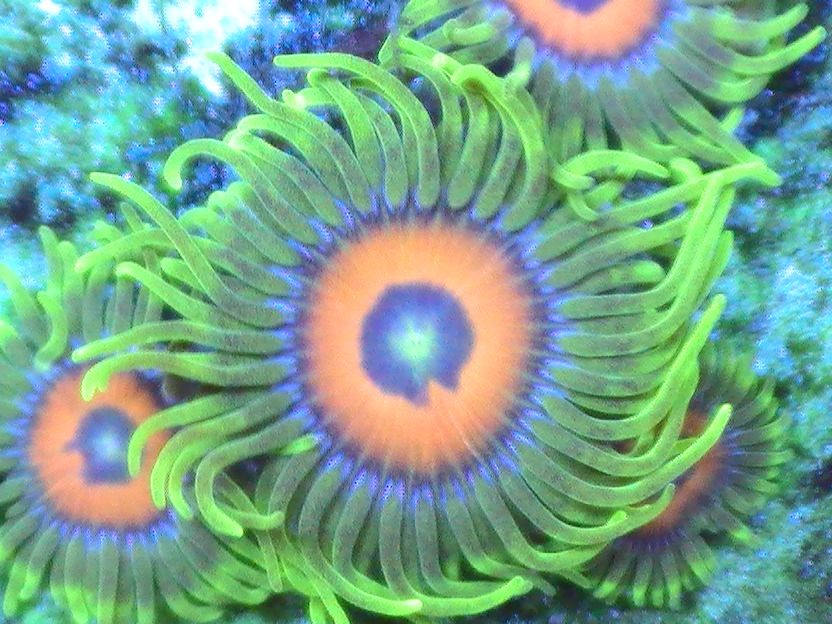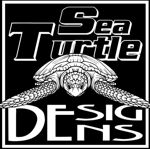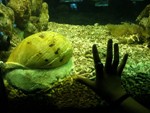Algae Control
in the
Marine Aquarium
By John H. Tullock
Copywright ©1996 All rights reserved
Algae becomes a problem when it interferes with the aesthetic appeal of the tank, or when rampant growth threatens to smother delicate organisms such as sessile invertebrates. There is no simple solution to the problem of controlling excess algae growth, because a variety of factors are involved. Of primary importance in the closed system of a marine aquarium is the accumulation of excessive levels of nutrient ions in the tank. Nitrate, phosphate, carbon dioxide and dissolved organic matter are the primary nutrient ions. These substances are in relatively short supply in the natural environment of the coral reef. In the aquarium, however, they can rapidly accumulate, providing "fertilizer" for explosive growths of filamentous, encrusting, and free floating algae. While there is no single, simple technique for limiting algae growth, attention to several important factors can result in an aquarium relatively free of excess algae.
Install a Protein Skimmer. One important algae nutrient is Dissolved Organic Matter (DOC). Removal of DOC by means of a protein skimmer is one of the simplest techniques of algae control. However, this approach alone will not work if attention is not paid to the other nutrients, as well. Besides removing DOC, protein skimmers lower the concentration of carbon dioxide in the water. The protein skimmer also reduces nitrate (see below) indirectly, because the DOC would eventually be decomposed into nitrate by bacteria if it were allowed to remain in the tank. Unlike other forms of filtration, protein skimming physically removes the pollutants from contact with the water. Using carbon or PolyFilterR does trap DOC, but water continues to flow over these media, and bacteria growing in them decompose the DOC, returning pollutants to the tank. Step one, then, in any plan to prevent algae from taking over your tank, is to install a protein skimmer.
Reduce Nitrate. Limiting the concentration of nitrates is not as simple as installing a piece of equipment. Nitrate also accumulates in the aquarium as the end product of biological filtration. Ninety percent of the nitrogen in foods added to the tank winds up as nitrate in the water. Regular partial water changes are one means of controlling nitrate. The amount and frequency of water changes will depend on the particular circumstances of each individual aquarium. Thus, one should perform a nitrate test weekly, and change water when the concentration of nitrate ion rises above a predetermined level. This level will vary, depending upon the circumstances of your individual aquarium. As a general rule, more frequent water changes are required for tanks that are densely populated with fish, and less frequent changes are required for tanks that are largely populated with invertebrates. A reasonable level would be less than 25 mg/l nitrate ion for fish only tanks, and about half this much for invertebrates. These levels are somewhat arbitrary; the ocean water around a coral reef has virtually no nitrate present. Nitrate test kits may measure either nitrate nitrogen (NO3-~N) or nitrate ion (NO3-). It is important to know which one your kit tests for. Nitrate nitrogen readings are multiplied by 4.4 to convert to nitrate ion readings.
Phosphate. Phosphate limitation is the single most effective means of algae control, but presents a problem from a practical point of view. Phosphate is found everywhere in nature, and enters the aquarium from a variety of sources: all foods, some salt mixes and tank additives, and especially tap water. Using water that is more purified than tap, well, or spring water has worked wonders for many aquarists who were formerly plagued with algae. One of the easiest ways to purify water at home is by reverso osmosis. A reverse osmosis units will produce 90% pure water for only pennies per gallon, and consumes only water. Keeping your aquarium clean, by removing accumulated detritus on a regular basis, will help to lower phosphates. Ideally, phosphates should be at zero concentration in the aquarium. The natural waters of the reef have almost no phosphate present. When aquarium water has 1.0 ppm phosphate or less, a phosphate removing material can be used to reduce the concentration significantly. Above this concentration, changing water, using seawater mix prepared with purified water, is a more practical solution.
Check your Salt Mix. If your salt mix contains phosphates, switch to one that does not.
Test for Phosphates. Ideally, there should never be any phosphate in your aquarium that is measurable with the Hach Low Range Phosphate Test Kit. This kit uses the ascorbic acid method, the only method that works well in seawater, and is accurate down to 0.05 mg/l. To my knowledge, it is the only phosphate test kit available that meets these specifications. You should have us test a sample of your tap water, also. If the tap water contains phosphates, I recommend installation of a reverse osmosis (RO) system.
Silica. Golden brown films that spread across the glass, substrate and decorations are growths of diatoms. Diatoms require a compound called silicate (SiO2-). Silicate enters the aquarium most often via tap water. If your tank develops this type of algae, the only satisfactory solution is to use RO water, not tap water.
Lighting. The sudden appearance of a "bloom" of diatoms, red slime algae, or blue-green slime algae is often indicative of the need to correct the aquarium's lighting. As lamps age, for example, their intensity diminishes and their spectral output changes, and this may trigger a growth of undesirable algae. Fluorescent lamps (standard output) should be changed at least once a year. VHO and HO lamps should be replaced every four and six months, respectively. Metal halide lamps have a longer life, but should probably be replaced annually to insure maximum intensity and spectral stability. The type of fluorescent lamp chosen can strongly influence the development of an algae bloom. Some lamps provide too much blue light, or aquarists use too many blue Actinic 03 lamps, and this appears to foster algae growth. While blue light is definitely needed by certain desirable algae species and by corals and anemones, a little goes a long way, as the saying goes. Proper selection of a lighting system depends upon the size and shape of the aquarium and the kinds of organisms that will live in the tank. The relationship between light and marine life is complicated and poorly understood, however.
Carbon Dioxide. Algae need carbon dioxide in order to grow. Aquarists rarely think about carbon dioxide, but it is often a source of problems. One of the basic causes of carbon dioxide accumulation is low output from pumps or powerheads. This can occur because too small a unit was chosen, or because the pump has slowed down due to age or lack of maintenance. Vigorous water movement is characteristic of coral reefs, and is important in the aquarium to prevent carbon dioxide buildup. Check the pH and alkalinity of your tank regularly. If either is chronically below normal, check to see if carbon dioxide is accumulating in the aquarium. This can be done simply. Remove a half-gallon sample of water from the tank and aerate it vigorously overnight. After 24 hours of aeration, check the pH of the sample. Check the pH of the tank at the same time. Compare the two readings. If the pH of the tank is over 0.2 pH units below that of the aerated sample, the tank is probably accumulating carbon dioxide. Correcting the problem will greatly reduce algae growth, and is essential for fish and invertebrate health.
Foster Coralline Algae Growth. Are you adding limewater in some form to the tank? Both pH and alkalinity should be correct, which will foster more coralline algae growth, and this in turn will help with the red slime, hair algae, and similar problem organisms. Besides limewater, which we make ourselves from dry powder (Julian Sprung's product, from Peter Wilkens in Germany), we add strontium and iodine supplements, both from Coralife. Phosphate lowering will also help.
Algae Eaters. Many species of marine life feed on algae, and some of these should be in every tank. Tangs, angelfishes, some blennies, rabbitfishes, sea urchins, hermit crabs, and many kinds of snails are in this category. These species will benefit from being able to graze on algae growth in the tank, and will keep the tank from looking "overgrown." Some of these are better suited to smaller tanks, while others are more appropriate for large tanks with many fishes. Still others are most useful in reef tanks.
It is also worth mentioning that additional filtration, especially biofiltration, is often recommended as a means of controlling excess algae growth. If anything, enhanced mineralization of nutrients that is accomplished with such filtration makes the nutrients more available to algae. Protein skimming, on the other hand, physically removes nutrients from contact with the water. Enhanced protein skimming, therefore, _will_ usually improve the situation. Activated carbon, often touted for its ability to "remove" organic matter, simply sequesters this material an allows it to be slowy decomposed by bacterial action. Again, if anything this makes nutrients more accessible for algae to assimilate. Ditto for any form of mechanical filtration, also.
Despite many claims to the contrary, the only way to control algae in the aquarium is to control the conditions that foster its growth. Primarily, these are water chemistry and the nature and amount of light falling upon the tank.
Algae Control
5 posts
• Page 1 of 1
Algae Control
Can't stop staring there is always new 
- jemzac
- reefphilippines member
- Posts: 1423
- Joined: Sun Jul 10, 2011 11:22 am
- Location: Sta. Rosa City, Laguna
Re: Algae Control
thanks sa post ms. jen... additional info... 
-

kentpoy23 - reefphilippines member
- Posts: 2037
- Joined: Wed Apr 06, 2011 2:34 pm
- Location: Las Piñas City
Re: Algae Control
mukhang iba naidulot sa'yo ni pedring ah. 
salamat po sa post na ito... sigurado akong marami ang maliliwanagan sa isyung ito.
salamat po sa post na ito... sigurado akong marami ang maliliwanagan sa isyung ito.
-

Sea Turtle - reefphilippines member
- Posts: 3005
- Joined: Mon Apr 19, 2010 9:35 pm
- Location: Las Pinas
Re: Algae Control
sipag ah  ...ayan para may babasahin tayo habang maulan sa labas
...ayan para may babasahin tayo habang maulan sa labas 

50G shallow nano-(retired)
Current tank-15G nano
-

rolandgelo - reefphilippines member
- Posts: 2017
- Joined: Mon Dec 27, 2010 4:23 pm
- Location: New Zealand
- jemzac
- reefphilippines member
- Posts: 1423
- Joined: Sun Jul 10, 2011 11:22 am
- Location: Sta. Rosa City, Laguna
5 posts
• Page 1 of 1
Who is online
Users browsing this forum: No registered users and 29 guests

